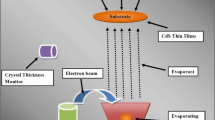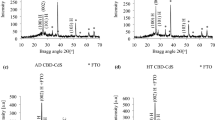Abstract
Owing to the greater efficiency in energy conversion by absorbing energy in a wider range of the solar spectrum, thin film CdS/CdTe solar cells have been popularized as a prominent application of photovoltaics and the technique of electrodeposition (ED) is an ideal method available for producing both CdS and CdTe materials upon its outrivaled simplicity, low cost, scalability and manufacturability. Typically the quality of these deposited thin films depends on several growth parameters and amid them, the type of conducting glass substrate plays a crucial role. This study is focused on the influence of conducting glass substrate on the properties of electrodeposited CdS and CdTe thin films. Two types of glass substrates coated with different transparent conducting oxide (TCO) layers namely; fluorine-doped tin oxide (FTO) and indium tin oxide (ITO) having different sheet resistances (FTO: 7 and 13 Ω/sq and ITO: 7 and 15 Ω/sq) were considered. CdS and CdTe materials were electrodeposited respectively on each of these types of TCO layers using a three electrode electrolytic system under a consistent set of growth parameters which has been pre-optimized with respect to FTO having sheet resistance of 7 Ω/sq. The deposited CdS and CdTe thin layers were subsequently heat treated and characterized to understand their optical, electrical, morphological and structural properties. Accordingly, CdS and CdTe semiconductor materials deposited on glass/FTO (7 Ω/sq) substrates have exhibited better optoelectronic qualities and hence, endorse the requirement of individual growth parameter optimization for each type of TCO glass substrate for the production of good quality CdS and CdTe thin films in photovoltaic device fabrications.









Similar content being viewed by others
References
T.M. Razykov, C.S. Ferekides, D. Morel, E. Stefanakos, H.S. Ullal, Solar photovoltaic electricity: current status and future prospects. Sol. Energy 85(8), 1580–1608 (2011)
I.M. Dharmadasa, Advances in Thin Film Solar Sells (Pan Stanford Publishing Pte. Ltd., Singapore, 2013), pp. 59–70
J. Nishino, S. Chatani, Y. Uotani, Y. Nosaka, Electrodeposition method for controlled formation of CdS films from aqueous solutions. J. Electroanal. Chem. 473, 217–222 (1999)
I.M. Dharmadasa, J. Haigh, Strengths and advantages of electrodeposition as a semiconductor growth technique for applications in macroelectronic devices. J. Electrochem. Soc. 153(1), G47–G52 (2006)
M.A.S. Aliyev, M. El-rouby, Electrochemical studies on the cathodic electrodeposition of n-type semiconductor CdS thin film from thiosulfate acidic aqueous solution. Int. J. Thin Films Sci. Technol. 205(3), 195–205 (2013)
I.M. Dharmadasa, A.A. Ojo, Unravelling complex nature of CdS/CdTe based thin film solar cells. J. Mater. Sci.: Mater. Electron. 28, 16598–16617 (2017)
I.M. Dharmadasa, P. Bingham, O. Echendu, Fabrication of CdS/CdTe-based thin film solar cells using an electrochemical technique. Coatings 4(3), 380–415 (2014)
H.Y.R. Atapattu, D.S.M. De Silva, K.A.S. Pathiratne, I.M. Dharmadasa, An investigation into the effect of rate of stirring of bath electrolyte on the properties of electrodeposited CdTe thin film semiconductors. J. Mater. Sci.: Mater. Electron. 29, 6236–6244 (2018)
H.Y.R. Atapattu, D.S.M. De Silva, K.A.S. Pathiratne, I.M. Dharmadasa, Effect of stirring rate of electrolyte on properties of electrodeposited CdS layers. J. Mater. Sci.: Mater. Electron. 27(5), 5415–5421 (2016)
O.K. Echendu, F.B. Dejene, I.M. Dharmadasa, An investigation of the influence of different transparent conducting oxide substrates/front contacts on the performance of CdS/CdTe thin-film solar cells. J. Mater. Sci.: Mater. Electron. 28(24), 18865–18872 (2017)
H.Y.R. Atapattu, D.S.M. De Silva, K.A.S. Pathiratne, O.I. Olusola, I.M. Dharmadasa, Necessity and relevance of a precipitate free clear electrolyte for electrodeposition of CdS semiconductor materials with enhanced photovoltaic activities. J. Mater. Sci.: Mater. Electron. 28, 18592–18602 (2017)
C. You, Y. Lin, C. Liu, C. Wu, Dependences of the structural, compositional and photoluminescent properties of electrodeposited CdS films upon thermal annealing. J. Lumin. 146, 109–113 (2014)
D.H. Rose, F.S. Hasoon, R.G. Dhere, D.S. Albin, R.M. Ribelin, X.S. Li, Y. Mahathongdy, T.A. Gessert, P. Sheldon, Fabrication procedures and process sensitivities for CdS/Cdte solar cells. Prog. Photovolt. 7, 331–340 (1999)
S.K. Das, Characterisation of CdCl2 treated electrodeposited CdS/CdTe thin film solar cell. Sol. Energy Mater. Sol. Cells 29, 277–287 (1993)
K.C. Wedisinghe, H.Y.R. Atapattu, D.S.M. De Silva, Electrodeposition and characterization of CdTe semiconductor thin films using a two electrode electrolytic system, in International Research Symposium on Pure and Applied Sciences (2016), p. 47
M. Grätzel, Photoelectrochemical cells. Nature 414(6861), 338–344 (2001)
D. Kwak, B. Moon, D. Lee, C. Park, Comparison of transparent conductive indium tin oxide, titanium-doped indium oxide, and fluorine-doped tin oxide films for dye-sensitized solar cell application. J. Electr. Eng. Technol. 6(5), 684–687 (2011)
S.G. Kumar, K.S.R.K. Rao, Physics and chemistry of CdTe/CdS thin film heterojunction photovoltaic devices: fundamental and critical aspects. Energy Environ. Sci. 7(1), 45–102 (2014)
J.M. Nel, H.L. Gaigher, F.D. Auret, Microstructures of electrodeposited CdS layers. Thin Solid Films 436, 186–195 (2003)
K.D. Rogers, J.D. Painter, M.J. Healy, D.W. Lane, M.E. Ozsan, The crystal structure of CdS/ CdTe thin film heterojunction solar cells. Thin Solid Films 339, 299–304 (1999)
Acknowledgements
Financial support from the University Grants Commission (UGC), Sri Lanka under the UGC Innovative Research Grants is acknowledged.
Author information
Authors and Affiliations
Corresponding author
Rights and permissions
About this article
Cite this article
De Alwis, A.C.S., Atapattu, H.Y.R. & De Silva, D.S.M. Influence of the type of conducting glass substrate on the properties of electrodeposited CdS and CdTe thin films. J Mater Sci: Mater Electron 29, 12419–12428 (2018). https://doi.org/10.1007/s10854-018-9358-8
Received:
Accepted:
Published:
Issue Date:
DOI: https://doi.org/10.1007/s10854-018-9358-8




